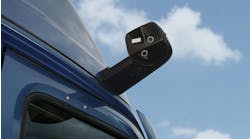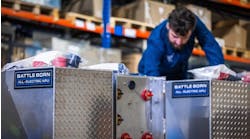Telematics provide fleets and shops with a wealth of information, from engine health to efficiency and performance metrics, though not every employee knows how to cash in on the information age’s oft-misunderstood digital currency.
They likely get that fault codes, for example, indicate a problem on a truck, but is it minor or major, and will it impact the business, or is it more technological white noise?
To help alleviate this, modern remote diagnostics go a step further than sharing technical error codes. A remote diagnostics solution shares a vehicle’s fault codes and relevant vehicle data, such as location or mileage, using the vehicle’s telematics gateway to communicate this data to a remote database.
The database shares this information with the customer through SMS alerts, emails, or on a proprietary platform. But remote diagnostics go beyond simple error codes, as Paul Smith, VP of business development for custom solutions at Noregon, explains.
“It’s not just a matter of knowing if a vehicle needs repairs; you have to know where you can send it for repair,” Smith told Fleet Maintenance. “With TripVision, you can accurately diagnose issues, identify the needed repairs, and use that information to schedule an appointment, reserve a bay, and have the part ordered before the vehicle even arrives at the shop.
The investment can reduce downtime and maintenance expenses, according to Nick DiPietro, director of asset optimization and procurement for Lazer Logistics, a yard management services provider.
“Remote diagnostics undoubtedly represent a worthwhile investment for Lazer Logistics,” DiPietro said. “The ability to monitor vehicle health remotely helps prevent costly breakdowns and reduces maintenance expenses.”
Remote diagnostics today
A decade ago, fleets received access to an overwhelming amount of technical data for each vehicle. An important characteristic of modern remote diagnostics is making this data usable and accessible.
Remote diagnostics have a shared role across providers: sharing vehicles’ error codes, identifying likely problems, and facilitating their repairs.
From Kenworth to Western Star, every major heavy-duty truck brand offers its own remote diagnostics solution. Other providers, like Jaltest Telematics, offer brand-agnostic diagnostics for fleets using a mix of trucks or platforms.
User-friendly diagnostics solutions help to elevate less technically proficient staff to understand fault code relations, follow complex operations, and know the urgency of certain repairs.
“It was a task to understand the data and what insights could be derived,” Noregon’s Smith said. “But now remote diagnostics is at the forefront of dealer and fleet maintenance strategies—and they’re being used in ways that they’ve never been used before.”
According to DiPietro, Lazer Logistics has seen significant value in using Noregon’s remote diagnostics solution over the last decade.
“We began utilizing telematics and remote diagnostics in 2015, integrating TripVision across our entire fleet,” DiPietro said. “One of the most important initiatives to come out of this new technology was the ability for real-time monitoring and diagnostics of vehicles and equipment.
Today, remote diagnostics is one of the most important functions of telematics solutions. A 2023 Noregon survey of fleets found remote diagnostics was the absolute most important telematics-enabled feature.
Accessible fault information
Since mid-2012, Volvo Trucks North America made remote diagnostics standard on every one of its vehicles. The main benefit, according to Magnus Gustafson, VTNA VP of Connected Services, is concisely “to add context.”
“Alongside fault data, remote diagnostics solutions also share convenient, accessible information about the code: what it means, how urgent it might be, and the likely parts and services necessary for repairs,” Gustafson said.
Remote diagnostics also help users understand their vehicles’ problems without needing thorough expertise.
“It’s difficult to diagnose issues by just looking at fault codes, so you have to look at patterns. You have to look at operational values,” Gustafson said. “You take a third-party solution and you say ‘I have this fault code,' that may mean something. But if it’s this code with that code with something else, that may mean something different.”
Volvo has an analytics engine that listens to truck data and follows a set of logic rules that dictate remote diagnostics behavior. This rule engine, according to Gustafson, allows the OEM to be highly accurate in its diagnoses.
“We take those complicated SAE industry explanations for fault codes and we actually tell you how it’s affecting your vehicle,” Noregon’s Smith said. “We make some recommendations and then we spell out an action plan.”
See also: FMCSA’s administrator turnover troubles have been bipartisan
Clear fault urgency
Fault urgency guidance is a staple feature of remote diagnostics solutions. A solution’s urgency rating helps users understand the impact an error will have on the vehicle.
“If you’re using it the way it’s designed, it’s an early warning system,” Smith said.
VTNA’s urgency classification, for example, has two color-coded categories: yellow and red.
“We do yellow cases, which means you need to attend this issue, but the truck can finish it’s mission; versus a red case, or alert, which is something that requires immediate attention and probably will end up diverting that truck,” Gustafson explained.
Other providers, like Kenworth and Noregon, use a four-color classification system: green, yellow, orange, and red.
When a vehicle stops running, it costs a fleet money. Broad, color-coded urgency categories help users understand quickly whether they can keep running the vehicle. Many non-urgent repairs can be added to existing planned services, easily reducing downtime.
Quick, coordinated repair
Many remote diagnostics platforms can also connect fleets to support staff or nearby shops to facilitate repairs. This can reduce fleets’ downtime and enhance shops’ efficiency.
“You don’t have to take the truck out of service if you don’t have to; that’s the ultimate benefit,” Gustafson said. “The second is, if the truck gets diverted to a dealership for a repair, what we see is, because it’s pre-diagnosed, it’s about 20 to 22% faster turnaround time.”
The result for maintenance staff is saved time, swift repairs, and well-planned operations.
Lazer Logistics’ DiPietro finds that remote diagnostics boosts the company’s efficiency by enabling proactive maintenance. Basing maintenance intervals on the vehicle’s actual condition, rather than fixed intervals, can lead to savings in both time and money.
“Moreover, remote diagnostics contribute to overall fleet safety by identifying potential issues before they escalate, thereby enhancing driver and public safety on the roads,” DiPietro said. “This early notification allows us to dispatch maintenance crews equipped with the necessary tools and parts to the exact location of the breakdown swiftly. By diagnosing issues remotely, we minimize downtime significantly, ensuring that operations remain efficient and disruptions are kept to a minimum.”
What might the future hold?
Over time, remote diagnostics solutions have incrementally become more accurate, informational, and useful for fleets and shops.
Solutions’ diagnostic logic is always improving, reducing false diagnoses. Vehicles are still becoming smarter each year, adding significant new streams of data on key assets outside the powertrain.
“Every time I turn around, there’s a new sensor on a vehicle that’s delivering data to someone’s cloud or someone’s UI,” Smith said. “There’s lots of room to grow in the future with remote diagnostics as we start to incorporate things like intelligent trailer data, tracker data, and advanced driver assistance systems data.”
VTNA’s new VNL, for example, introduces a new 24-volt electrical architecture that Gustafson said will enable faster, lighter, and more accurate diagnostics operations.
Looking further ahead, Noregon’s Smith thinks that artificial intelligence could find even more accurate diagnostics from the growing wealth of asset data available. Even further, maybe vehicles that make their own appointments.
“And then we start talking way into the future with autonomy. Imagine a vehicle that can self-diagnose and self-schedule its own maintenance appointment,” Smith said. ”A technician in a shop walks into the bay, and his schedule is already planned out because vehicles are automatically scheduling their own maintenance. Isn’t that something?”




